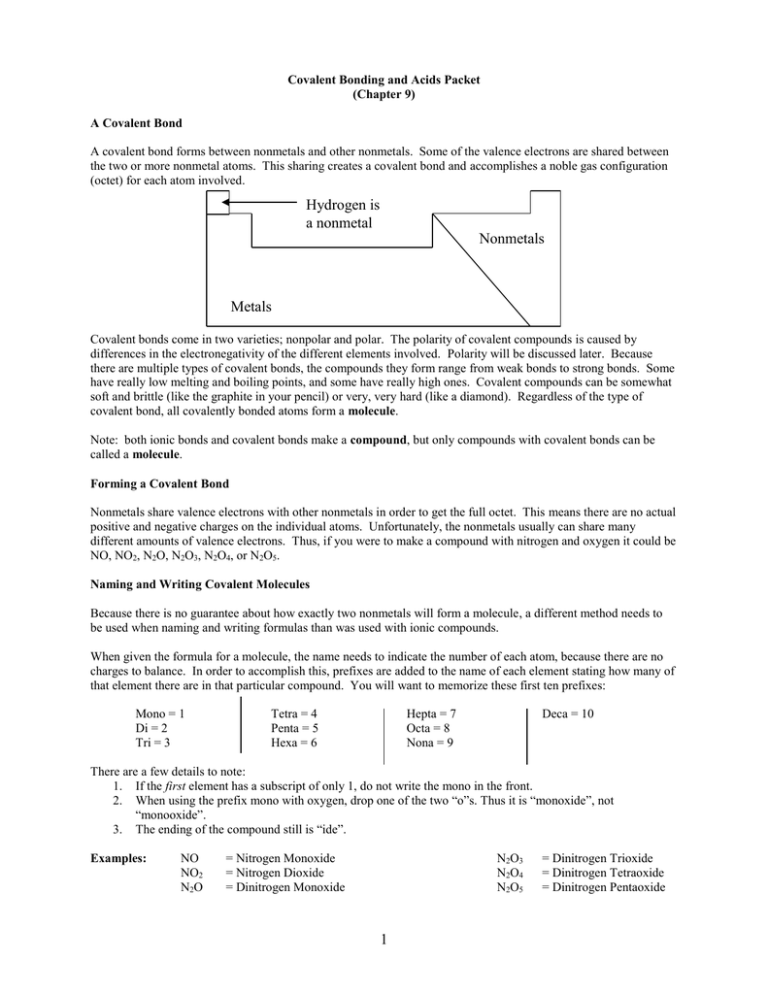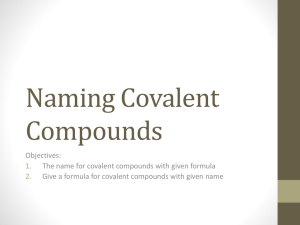The Super Covalent Bonding Packet
advertisement

Covalent Bonding and Acids Packet (Chapter 9) A Covalent Bond A covalent bond forms between nonmetals and other nonmetals. Some of the valence electrons are shared between the two or more nonmetal atoms. This sharing creates a covalent bond and accomplishes a noble gas configuration (octet) for each atom involved. Hydrogen is a nonmetal Nonmetals Metals Covalent bonds come in two varieties; nonpolar and polar. The polarity of covalent compounds is caused by differences in the electronegativity of the different elements involved. Polarity will be discussed later. Because there are multiple types of covalent bonds, the compounds they form range from weak bonds to strong bonds. Some have really low melting and boiling points, and some have really high ones. Covalent compounds can be somewhat soft and brittle (like the graphite in your pencil) or very, very hard (like a diamond). Regardless of the type of covalent bond, all covalently bonded atoms form a molecule. Note: both ionic bonds and covalent bonds make a compound, but only compounds with covalent bonds can be called a molecule. Forming a Covalent Bond Nonmetals share valence electrons with other nonmetals in order to get the full octet. This means there are no actual positive and negative charges on the individual atoms. Unfortunately, the nonmetals usually can share many different amounts of valence electrons. Thus, if you were to make a compound with nitrogen and oxygen it could be NO, NO2, N2O, N2O3, N2O4, or N2O5. Naming and Writing Covalent Molecules Because there is no guarantee about how exactly two nonmetals will form a molecule, a different method needs to be used when naming and writing formulas than was used with ionic compounds. When given the formula for a molecule, the name needs to indicate the number of each atom, because there are no charges to balance. In order to accomplish this, prefixes are added to the name of each element stating how many of that element there are in that particular compound. You will want to memorize these first ten prefixes: Mono = 1 Di = 2 Tri = 3 Tetra = 4 Penta = 5 Hexa = 6 Hepta = 7 Octa = 8 Nona = 9 Deca = 10 There are a few details to note: 1. If the first element has a subscript of only 1, do not write the mono in the front. 2. When using the prefix mono with oxygen, drop one of the two “o”s. Thus it is “monoxide”, not “monooxide”. 3. The ending of the compound still is “ide”. Examples: NO NO2 N2O = Nitrogen Monoxide = Nitrogen Dioxide = Dinitrogen Monoxide N2O3 N2O4 N2O5 1 = Dinitrogen Trioxide = Dinitrogen Tetraoxide = Dinitrogen Pentaoxide Exercise 1: Write the name of each of the following molecular compounds. The number of the subscript becomes the amount of the prefix. Remember: 1. If the first element has a subscript of only 1, do not write the mono in the front. 2. When using the prefix mono with oxygen, drop one of the two “o”s. 3. The ending of the compound still is “ide”. 1. OF2 __________________________________________________ 2. Cl2O8 __________________________________________________ 3. SO3 __________________________________________________ 4. P4O10 __________________________________________________ 5. CO __________________________________________________ 6. CH2 __________________________________________________ 7. N2H4 __________________________________________________ 8. ClO3 __________________________________________________ 9. CCl4 __________________________________________________ 10. H2S __________________________________________________ 11. N2O5 __________________________________________________ 12. P4S3 __________________________________________________ 13. SO2 __________________________________________________ 14. S2F10 __________________________________________________ 15. SF6 __________________________________________________ When writing the formulas for named molecules, there is no need to worry about criss-crossing charges as the prefixes already state how many of each element there is in the molecule. Simply turn the prefixes into subscripts. Exercise 2: Write the formulas for the following named molecules. Do not write subscripts of 1. 1. Carbon Tetrabromide ____________ 2. Dichlorine Heptaoxide ____________ 3. Dinitrogen Pentaoxide ____________ 4. Boron Trichloride 5. Dinitrogen Tetrahydride ____________ 6. Diphosphorus Trioxide ____________ 7. Carbon Disulfide 8. Dinitrogen Tetraoxide ____________ ____________ ____________ 9. Phosphorus Pentachloride ___________ 10. Nitrogen Trifluoride ____________ 11. Disulfur Dichloride ____________ 12. Dichlorine Trioxide ____________ 13. Nitrogen Triiodide ____________ 14. Boron Trifluoride ____________ 15. Sulfur Hexafluoride ____________ 16. Phosphorus Pentachloride ___________ 2 Acids Acids are special molecules that when dissolved in water will produce an H + ion as it breaks apart. For example, HCl dissolves in water to form H+ and Cl- ions. This makes HCl an acid when dissolved in water, otherwise as a gas it is just hydrogen chloride. There are two major types of acids, those with oxygen and those without. If the acid does NOT have oxygen in the formula, then it’s called a binary acid. If the acid does have oxygen in the formula, then it’s called an oxyacid. Binary Acids Binary acids contain hydrogen and only one other element, however there may be more than one of the hydrogen. It is still going to be necessary to balance out the negative charges of the nonmetal with enough hydrogens to form a neutral (zero charge) compound. Thus the criss-cross method will still be used. Exercise 3: 1. Write the charge for each of the following nonmetals. 2. Criss-cross the following with enough hydrogens to form a neutral compound. Write the formula in the box. Do not write subscripts of 1 or “+” and “-“ charges. N F P S H+ 1 2 Cl 3 Se 4 Br I H+ 5 6 7 8 There is a special form that is used to name a binary acid: “Hydro_________ic Acid” All acids will end with the word “Acid”. The blank in the above form is filled in with the root of the element that the hydrogen is bonded to. All the possible roots are: Bromine = brom Chlorine = chlor Fluorine = fluor Iodine = iod Nitrogen = nitr Phosphorus = phosphor Selenium = selen Sulfur = sulfur Exercise 4: For each of the molecules made in exercise 3, write the name of the molecule as if it was an acid. 1. _______________________________________________________________________ 2. _______________________________________________________________________ 3. _______________________________________________________________________ 4. _______________________________________________________________________ 5. _______________________________________________________________________ 6. _______________________________________________________________________ 7. _______________________________________________________________________ 8. _______________________________________________________________________ 3 Oxyacids Oxyacids must have hydrogen to be considered an acid, and must have oxygen to be considered an oxyacid, and there still must be a third element present to hold it all together. Thus an oxyacid has three elements. Basically this makes oxyacids look like polyatomic ions bonded to hydrogens. Also, for the purposes of naming the acid the name of the polyatomic ion is needed, so use the list on the Bonding Cheat Sheet for the following practice. If you group all the polyatomic ions of chlorine and oxygen from the Bonding Cheat Sheet, a pattern will form: ClOClO2 ClO3 ClO4 - Hypochlorite Chlorite Chlorate Perchlorate “Hypo” means “lacking”, so hypochlorite has the lowest amount of oxygens, and Per comes from “hyper” which means “excessive”, so perchlorate has the most oxygen. This pattern also follows for the rest of the Halogens, so the following are NOT found on the Bonding Cheat Sheet, but will be used for the following practice. Exercise 5: Write in the names for the other halogen-oxygen polyatomic ions. Use the pattern shown above. 1. FO2. FO2- 3. FO3- 9. IO- _________________________ _________________________ _________________________ 4. FO4- _________________________ _________________________ 10. IO2- _________________________ 11. IO3- _________________________ 12. IO4- _________________________ 5. BrO- _________________________ 6. BrO2- _________________________ 7. BrO3- _________________________ 8. BrO4- _________________________ Like with the binary acids, oxyacids need enough hydrogens to balance out the charge on the polyatomic ion part. Thus once again it is necessary to criss-cross to form the compounds. Exercise 6: Criss-cross the following polyatomic ions with hydrogen and write the compound in the space. It will not be necessary to use parentheses or reduce. AsO3 -3 BO3 -3 ClO2 - CrO4 -2 Cr2O7 -2 ClO- H+ 1 2 C2O4 -2 3 MnO4 - 4 PO3 -3 5 SO3 -2 6 S2O3 -2 IO4- H+ 7 8 9 10 4 11 12 When naming oxyacids a name change is necessary. The hydrogen is not mentioned because it obviously needs to be there for the molecule to be an acid. If the polyatomic ion ends in “ite”, then those letters are changed to “ous” for the name of the oxyacid. If the polyatomic ion ends in “ate”, then those letters are changed to “ic” for the name of the oxyacid. Often a little saying is suggested for remembering this change: I ate it and it was ic-ky The pneumonic is a reminder that “ate” turns to “ic”, and then by default “ite” turns to “ous”. Once the name has been changed, the word “acid” is still added to the end. Examples: HC2H3O2 As a solid: Hydrogen Acetate As an acid: Acetic Acid HNO2 As a solid: Hydrogen Nitrite As an acid: Nitrous Acid So “ate” get replaced with “ic” and “ite” gets replaced with “ous”, the hydrogen does not get named, and the word “acid” is added. Exercise 7: Name the molecules from exercise 6 as acids. Change the endings and add the word acid as necessary. 1. __________________________________________________________ 2. __________________________________________________________ 3. __________________________________________________________ 4. __________________________________________________________ 5. __________________________________________________________ 6. __________________________________________________________ 7. __________________________________________________________ 8. __________________________________________________________ 9. __________________________________________________________ 10. __________________________________________________________ 11. __________________________________________________________ 12. __________________________________________________________ When writing the formulas for acids, the clue that it is an acid is the word “acid” on the end. 1. Determine if it is a binary acid or an oxyacid. 2. Determine which elements or polyatomic ions are involved. 3. Criss-cross so that there are enough hydrogens to balance out the charge on the second part of the acid. Exercise 8: Write the formulas for the following acids. Follow the steps above. 1. Arsenic Acid _______________ 2. Sulfuric Acid _______________ 3. Perchloric Acid _______________ 4. Hydrobromic Acid _______________ 5. Hydronitric Acid _______________ 6. Cyanic Acid _______________ 7. Silicic Acid _______________ 8. Phosphoric Acid _______________ 9. Hydroselenic Acid _______________ 10. Hydrosulfuric Acid _______________ 11. Nitric Acid _______________ 12. Hypoiodous Acid _______________ 13. Bromous Acid _______________ 14. Hydrophosphoric Acid _______________ 15. Fluorous Acid _______________ 16. Chloric Acid 5 ________________





